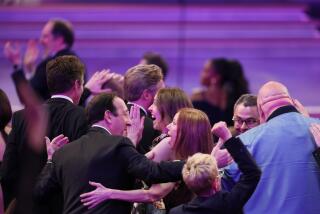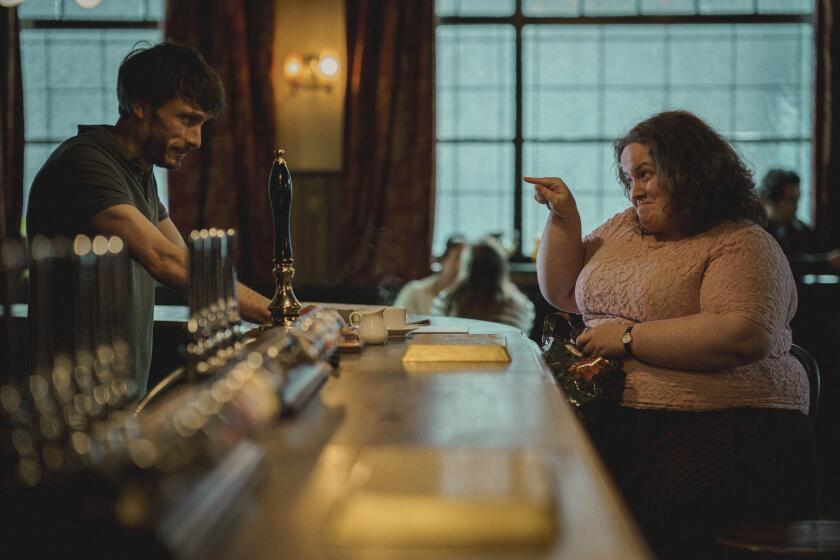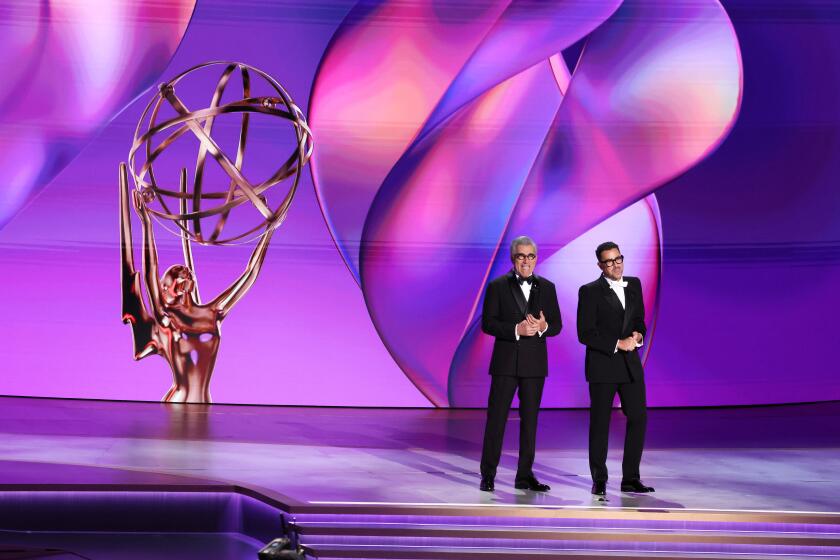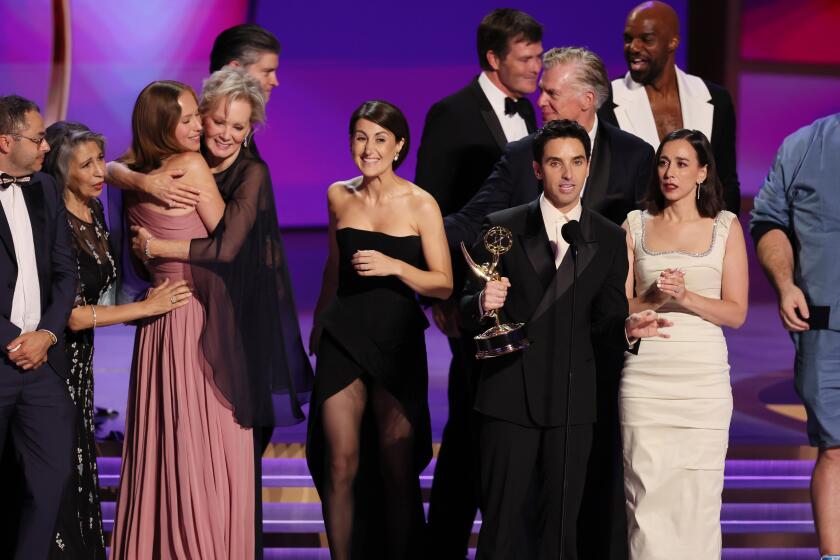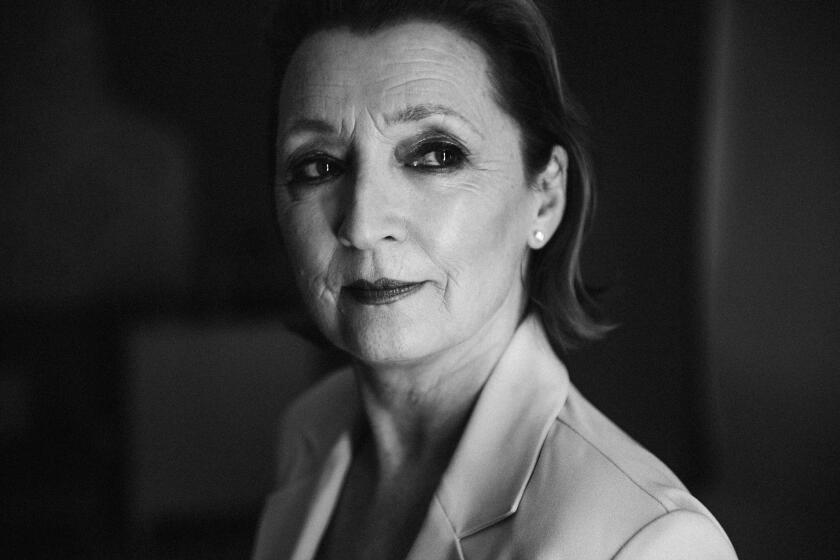Scenes from 4 top Emmy contenders go under the microscope
If a hair or a drop of blood can unlock the whole sequence of a human being’s DNA, it makes sense that a single scene in an outstanding television series can also be a microcosm, encapsulating in miniature the elements that make the show so engrossing. Come Emmy awards time, certain specimens of the genus episodic dramaticus seem to thrive year after year. To find out what makes them tick, we put pivotal scenes from the current seasons of four top contenders (including this week’s “Mad Men,” so be forewarned) under the microscope.
The Good Wife (CBS)
The scene: Will (Josh Charles) confronts Alicia (Julianna Margulies) in her office after he learns that she plans to leave the firm, taking its top clients with her (from Season 5, Episode 5, “Hitting the Fan”).
What happens: Will questions Alicia quietly and then explodes in a rage, sweeping her desk clean, confiscating her phone, telling her she’s fired and calling security. When Alicia is defiant, Will screams so hard about how he hired her when no one else would that he nearly chokes.
Why it’s essential: These are the two people whose relationship we’ve become most invested in, splitting apart in a way that feels irrevocable. It’s emotionally layered — even while churning with anger, Will flashes back to glimpses of Alicia between the sheets when they were lovers. It’s also bold, brutal and even funny: the fireworks kick off the episode, rather than being deployed as a cliffhanger; we watch two sharp lawyers deploy cold-blooded, beat-the-clock maneuvers; and the firm implodes just minutes after a publicist praises its stability.
Insider insight: The blurred lines between career and emotional life have been at the core of the show, say co-creators Robert and Michelle King. “We wanted to turn the chemistry that’s always been there between Will and Alicia from love to hate, and have you sympathize with both sides while it moves back and forth between who’s winning and who’s losing,” says Robert. Adds Michelle: “Alicia’s right when she stands up to him, but then you see it’s so she can buy some time to get files out the door. Both Josh and Julianna did a spectacular job with it. I think it’s our favorite scene of theirs.”
Justified (FX)
The scene: When Ava (Joelle Carter) arrives on the bridge to Harlan for a moonlight rendezvous with Raylan (Timothy Olyphant), we learn the high cost of the deal she has struck to get herself released from prison (from Season 5, Episode 13, “Restitution”).
What happens: We knew Ava was as good as dead if she stayed in the lockup, but it’s still a shock to learn she’s agreed to help Raylan bring down Boyd (Walt Goggins), his nemesis and her estranged fiance. Ava admits she’s scared, and Raylan tells her everything will be fine.
Why it’s essential: It exemplifies the strategizing and betrayals that “Justified” thrives on, and sets the table for all the mayhem to come in the final season. The series’ hillbilly noir aesthetic is beautifully expressed, with Raylan in his long duster and cowboy hat stepping into the headlights as the ex-lovers meet between cars stopped at opposite ends of the dark bridge. It’s simple, but freighted with so much subtext and history.
Insider insight: “Ava enters that bridge so honest and bare, saying, ‘I get how this works; I made this deal,’” says Carter. “But if Raylan is as smart as we all make him out to be, he knows she’s going to try to help Boyd in this situation. The scene puts her right back to where she was in the pilot, between these two men who want to destroy each other. Now she has to figure out a way to save herself, so that she comes out of this with her integrity and loyalties intact. This is poker, people. It’s going to be a three-way game of strategy.” Adds creator Graham Yost: “Raylan tells Ava everything is going to be OK, which means he now carries the burden of being responsible for her life. That gives us a lot of fun and scary places to go next season.”
Game of Thrones (HBO)
The scene: Joffrey (Jack Gleeson), the despised young ruler of the Seven Kingdoms, chokes to death at his own wedding (from Season 4, Episode 2, “The Lion and the Rose”).
What happens: While hosting the wedding feast, Joffrey relentlessly humiliates his Uncle Tyrion (Peter Dinklage) and forces him to act as his cup-bearer. A flock of birds bursts from the wedding pie when the monstrous monarch whacks it with his new sword; that same pie becomes lodged in his throat as he chokes, calling out for the cup that may have poisoned him.
Why it’s essential: Provocation, humiliation, lavish spectacle and ghastly violence — much of what makes “Game of Thrones” so potent is heaped on a platter in this 12-minute extravaganza, which also up-ends the power structure, places Tyrion under arrest and opens up a whodunit in which so many players have a motive.
Insider insight: “It’s one of the rare scenes that brings so many series regulars together in one place, and gives rise to all this scheming and bickering,” says David Benioff, who co-created the series with D.B. Weiss, based on the book by George R.R. Martin. “In the book,” says Weiss, “the dancing dwarves [entertaining at the wedding] were riding on pigs. We learned that pigs won’t carry people, and besides, it would have been an animal rights violation. But Joffrey’s behavior reminds you of all the horrible things he’s been a party to, and why so many of the people at the wedding would want him dead.” The scene also drives much of the action going forward, says Weiss, as “characters twist what’s happened to serve their own ends.” “We usually ramp up more slowly,” Benioff points out, “but in this case, we wanted to shake things up.”
Mad Men (AMC)
The scene: Don and Peggy (Jon Hamm and Elisabeth Moss) grapple with a changing culture and definition of family while they brainstorm a new pitch for the Burger Chef account during a late-night session at the office (from Season 7, Episode 6, “The Strategy”).
What happens: In contrast to a corresponding scene in “The Suitcase,” the classic Season 4 episode, Don and Peggy now relate as equals; with insight from Don, Peggy is now learning what it truly means to be the boss. Deep into the work session, they each confess their own fears and regrets, which leads Peggy to a solution for the pitch. With his pride in her evident, Don invites Peggy to join him in a slow dance while the radio plays Sinatra’s “My Way.”
Why it’s essential: If this season is about the seismic cultural shift from the midcentury heyday of guys like Don to the upheavals of the late ‘60s; here we have Don and Peggy working that out in miniature. In a poignant, penetrating way, each is moved to own their choices and who they are, even as they recognize what it’s cost them.
Insider insight: The season began with Don and Peggy both miserable and at loggerheads. “We wanted to tell a story that moves them from being so completely far apart to being this close again,” says “Mad Men” creator Matthew Weiner. “This is not a romantic relationship, but it’s about two people, in the most earned way, realizing that they’re family.” Seeing Don fight to regain his job has shown us how essential it is to his identity. Peggy is perhaps the only woman in his life who truly gets that. “You see Don realize what she means to him,” says Weiner. As they work together on the pitch, “the solution comes out of their feelings, which is one of the premises of the show — that creativity is not intellectual.” As for the iconic Sinatra tune, “it had just come out in 1969,” Weiner points out. “The people who like Frank are still around. The rock and roll part of the ‘60s did not dominate the commercial world. These two cultures were at odds the entire time.”
Sign up for the Envelope Newsletter
More to Read
From the Oscars to the Emmys.
Get the Envelope newsletter for exclusive awards season coverage, behind-the-scenes stories from the Envelope podcast and columnist Glenn Whipp’s must-read analysis.
You may occasionally receive promotional content from the Los Angeles Times.

